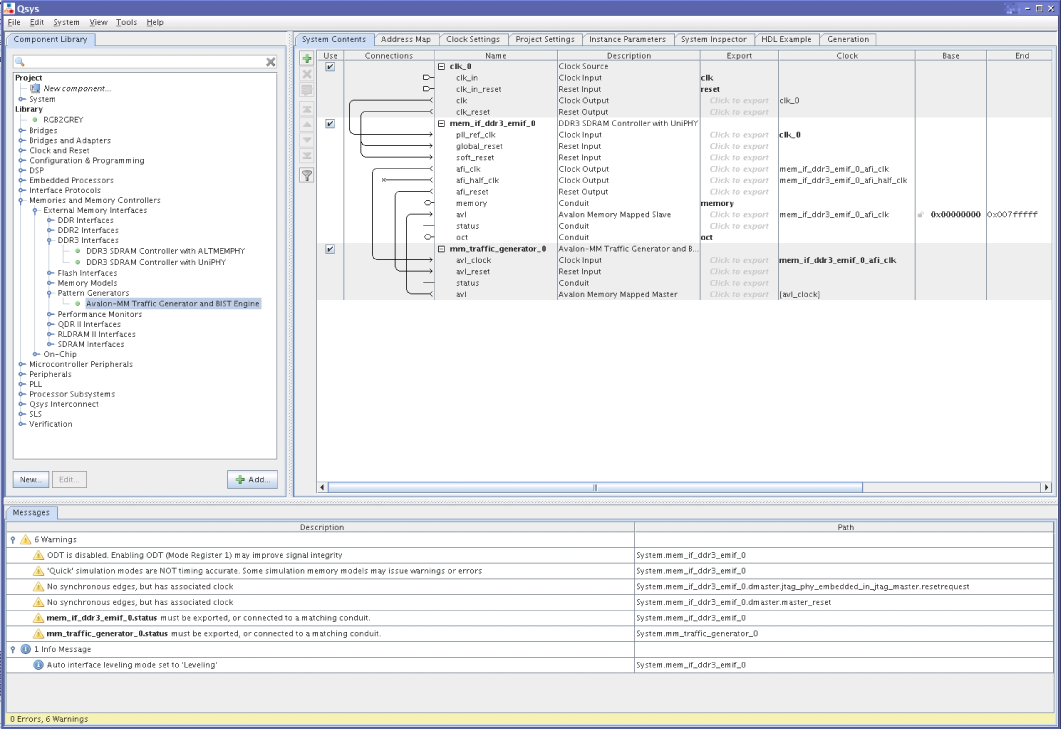External Memory Interface Handbook Volume 3: Reference Material: For UniPHY-based Device Families
ID
683841
Date
3/06/2023
Public
1. Functional Description—UniPHY
2. Functional Description— Intel® MAX® 10 EMIF IP
3. Functional Description—Hard Memory Interface
4. Functional Description—HPS Memory Controller
5. Functional Description—HPC II Controller
6. Functional Description—QDR II Controller
7. Functional Description—RLDRAM II Controller
8. Functional Description—RLDRAM 3 PHY-Only IP
9. Functional Description—Example Designs
10. Introduction to UniPHY IP
11. Latency for UniPHY IP
12. Timing Diagrams for UniPHY IP
13. External Memory Interface Debug Toolkit
14. Upgrading to UniPHY-based Controllers from ALTMEMPHY-based Controllers
1.1. I/O Pads
1.2. Reset and Clock Generation
1.3. Dedicated Clock Networks
1.4. Address and Command Datapath
1.5. Write Datapath
1.6. Read Datapath
1.7. Sequencer
1.8. Shadow Registers
1.9. UniPHY Interfaces
1.10. UniPHY Signals
1.11. PHY-to-Controller Interfaces
1.12. Using a Custom Controller
1.13. AFI 3.0 Specification
1.14. Register Maps
1.15. Ping Pong PHY
1.16. Efficiency Monitor and Protocol Checker
1.17. UniPHY Calibration Stages
1.18. Document Revision History
1.7.1.1. Nios® II-based Sequencer Function
1.7.1.2. Nios® II-based Sequencer Architecture
1.7.1.3. Nios® II-based Sequencer SCC Manager
1.7.1.4. Nios® II-based Sequencer RW Manager
1.7.1.5. Nios® II-based Sequencer PHY Manager
1.7.1.6. Nios® II-based Sequencer Data Manager
1.7.1.7. Nios® II-based Sequencer Tracking Manager
1.7.1.8. Nios® II-based Sequencer Processor
1.7.1.9. Nios® II-based Sequencer Calibration and Diagnostics
1.17.1. Calibration Overview
1.17.2. Calibration Stages
1.17.3. Memory Initialization
1.17.4. Stage 1: Read Calibration Part One—DQS Enable Calibration and DQ/DQS Centering
1.17.5. Stage 2: Write Calibration Part One
1.17.6. Stage 3: Write Calibration Part Two—DQ/DQS Centering
1.17.7. Stage 4: Read Calibration Part Two—Read Latency Minimization
1.17.8. Calibration Signals
1.17.9. Calibration Time
4.1. Features of the SDRAM Controller Subsystem
4.2. SDRAM Controller Subsystem Block Diagram
4.3. SDRAM Controller Memory Options
4.4. SDRAM Controller Subsystem Interfaces
4.5. Memory Controller Architecture
4.6. Functional Description of the SDRAM Controller Subsystem
4.7. SDRAM Power Management
4.8. DDR PHY
4.9. Clocks
4.10. Resets
4.11. Port Mappings
4.12. Initialization
4.13. SDRAM Controller Subsystem Programming Model
4.14. Debugging HPS SDRAM in the Preloader
4.15. SDRAM Controller Address Map and Register Definitions
4.16. Document Revision History
10.7.1. DDR2, DDR3, and LPDDR2 Resource Utilization in Arria V Devices
10.7.2. DDR2 and DDR3 Resource Utilization in Arria II GZ Devices
10.7.3. DDR2 and DDR3 Resource Utilization in Stratix III Devices
10.7.4. DDR2 and DDR3 Resource Utilization in Stratix IV Devices
10.7.5. DDR2 and DDR3 Resource Utilization in Arria V GZ and Stratix V Devices
10.7.6. QDR II and QDR II+ Resource Utilization in Arria V Devices
10.7.7. QDR II and QDR II+ Resource Utilization in Arria II GX Devices
10.7.8. QDR II and QDR II+ Resource Utilization in Arria II GZ, Arria V GZ, Stratix III, Stratix IV, and Stratix V Devices
10.7.9. RLDRAM II Resource Utilization in Arria® V Devices
10.7.10. RLDRAM II Resource Utilization in Arria® II GZ, Arria® V GZ, Stratix® III, Stratix® IV, and Stratix® V Devices
13.1. User Interface
13.2. Setup and Use
13.3. Operational Considerations
13.4. Troubleshooting
13.5. Debug Report for Arria V and Cyclone V SoC Devices
13.6. On-Chip Debug Port for UniPHY-based EMIF IP
13.7. Example Tcl Script for Running the Legacy EMIF Debug Toolkit
13.8. Document Revision History
9.1.4. Creating and Connecting the UniPHY Memory Interface and the Traffic Generator in Platform Designer
The traffic generator can be used in Platform Designer as a stand-alone component for use within a larger system.
To create the system in Platform Designer, perform the following steps:
- Start Platform Designer.
- On the Project Settings tab, select the required device from the Device Family list.
- In the Component Library, choose a UniPHY memory interface to instantiate. For example, under Library > Memories and Memory Controllers > External Memory Interfaces, select DDR3 SDRAM Controller with UniPHY Intel FPGA IP.
- Configure the parameters for your instantiation of the memory interface.
- In the Component Library, find the example driver and instantiate it in the system. For example, under Library > Memories and Memory Controllers > Pattern Generators, select Avalon-MM Traffic Generator and BIST Engine.
- Configure the parameters for your instantiation of the example driver.
Note: The Avalon specification stipulates that Avalon-MM master interfaces issue byte addresses, while Avalon-MM slave interfaces accept word addresses. The default for the Avalon-MM Traffic Generator and BIST Engine is to issue word addresses. When using Platform Designer, you must enable the Generate per byte address setting in the traffic generator.
- Connect the interfaces as illustrated in the following figure. At this point, you can generate synthesis RTL, Verilog or VHDL simulation RTL, or a simulation testbench system.
